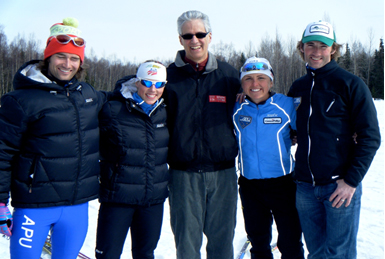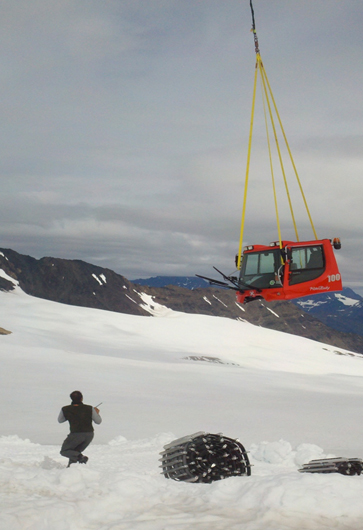 On Excellence
On Excellence
When it comes to excellence, the APU Nordic Ski Club has by all measures achieved it. It is considered to be the most successful regional Nordic Ski Club in the U.S, the one that other regional ski programs look to emulate. In 2011 the U.S. Ski and Snowboard Association (USSA) the national governing body for U.S. Olympic skiing and snowboarding, bestowed three awards upon the APU Nordic Ski Center:
- USSA Cross Country Club of the Year, presented to a USSA Competition Club in each sport having distinguished itself in providing direction to young athletes through to young athletes through high-level competition programs resulting in athletic success
- USSA Cross Country International Coach of the Year Award, to Erik Flora, based on outstanding contribution to either the domestic program or international program, resulting in high-level performance of his or her athletes in domestic or international competition
- USSA Cross Country Athlete of the Year Award, to Kikkan Randall, based upon results in domestic or international competition
In December 2011 APU Nordic Ski Club athletes made history as Kikkan and Sadie Bjornsen became the first American team to medal in a World Cup Nordic cross-country relay.
Much has been written in the academic literature about high performance work teams (HPWT) as the new model to replace traditional command and control bureaucratic methods and successful sports organizations are often cited in this literature.
Personally, I have a deep appreciation for non-bureaucratic, responsive, flexible, adaptive, creative organizational structures and HPWTs as my own academic training is in the field of organizational theory and behavior.
In his talk at APU’s May 2011 Nordic Ski fundraiser, Erik Flora credited his team’s success to three simple yet powerful principles: 1) set extremely high expectations, 2) foster the discipline to work intensely hard, and 3) create a climate of support for each other. In doing so, he articulated three of the key principles often cited in the literature on HPWTs. Other key principles are openness (in all communications among team members; this includes calling out another team member when they act irresponsibly and/or hurt the team), experience (drawing on the wisdom and experience of the most successful team members- in APU’s case the Olympian skiers), collaboration, and a sense of play that accompanies the hard work. For HPWTs to work each member of the team must embrace these principles and, having been around the APU Nordic Ski Club members, I can attest that they do. During their annual fund raisers, HPWT skills are on full display as they employ these same principles to produce remarkably successful events.
There is another key factor in the team’s success that has enabled them to compete with the Europeans and that is the Thomas Training Center on Eagle Glacier. Skiers can train on snow from October to August, longer than anywhere else in the country. This past summer the US women’s ski team joined them to train on the glacier for a blend of hard training, camaraderie, and fun.

Coach Erik Flora getting ready to “catch” the new pisten bully as it is airlifted onto Eagle Glacier
As a college President, I am equally impressed with the Nordic Ski Club team members’ academic work and their community service ethos. The Nordic Ski Center’s unique blend of educational opportunity and first-class coaching has drawn student athletes to Alaska Pacific University from all over the country. It is a broad-based program that serves the entire cross-country ski community in Anchorage from elementary-school beginners to adult master skiers. Many of the skiers earn university degrees as they train and compete e.g., I enjoyed hearing Sadie Bjornsen talk about how-on the morning of her World Cup ski race-she was busy writing an academic paper for one of her classes. In addition, the community outreach programs are designed to raise skill levels and engender a love of the sport in all ages and abilities of participants. The following newspaper excerpt is an excellent example of their community service ethos…
VERNON, British Columbia. In the tech center high above the stadium at the Sovereign Lake Nordic Centre, several race organizers looked outside at the Alaska Pacific University (APU) skiers.
They were doing it again.
At the end of the NorAm Cup competition Sunday — after the men’s and women’s distance races, and the boys’ and girls’ junior and juvenile races — those wearing the black APU jackets went to work. According to Chief of Stadium Don Wylie, it was the third straight year they broke down the course without being asked.
“It’s fantastic,” Wylie said as he watched those who had raced 10 and 15 k an hour or two earlier fold banners and carry barriers into a storage room.
“It’s a stadium that takes hours to put together and hours of hours to take down,” he said. “(With their help), it’s done in 15 minutes, and it really helps my people out.”
APU skier Peter Kling said it was practically a no-brainer after they spent three weeks in the area.
For more on the APU Nordic Ski Club, check out wowapu.com.
